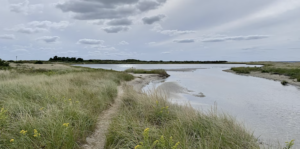
Land Trusts and the Commons Sector
…
“In my mind, the great challenge for the twenty-first century is to make the commons visible, to give it proper reverence, and to translate that reverence into property rights and legal institutions that are on a par with those we currently give to private property.”
—Peter Barnes, Capitalism, the Commons, and Divine Right‘
…
Imagine a pond filled with fish. The pond is large to the point of appearing boundless, and the fish are highly competitive, with the capacity to grow infinitely in size depending on how successfully they consume the pond’s shared resources. The catch, no pun intended, is that while the fish can grow infinitely in size, the pond’s resources are limited. It’s easy to imagine this scenario ending with one enormous fish wasting away in a pond stripped of its former bounty.
This is the scenario imagined by the entrepreneur and writer Peter Barnes in his 2003 lecture for the Schumacher Center of New Economics, Capitalism, the Commons, and Divine Right. Barnes outlines two major flaws of capitalism and posits a system of commons-based property rights that bear a close resemblance to Agrarian Trust’s work today. His lecture provides valuable insight into how restoring the commons can counter the negative effects of capitalism, and it’s worth checking out the full version if you have the time. But if not, let’s get back to the fish metaphor.
Limitless Growth Drains the Pond.
For Barnes, the pond is the commons and the fish are corporations. Like the pond, the commons are the shared context in which all market dynamics take place. The commons are the source of natural resources, culture, and communication, and a waste sink for the cast-offs of human civilization. The ocean or atmosphere, are fairly straightforward examples of a commons as Barnes understands it—both are a source of natural resources, and a suitable spot (for some) to put anything you no longer need.
The big, world-eating fish, on the other hand, represent the market logic of short-term growth for the benefit of a small number of shareholders. Think fossil fuel companies spewing carbon into the atmosphere, or timber companies clear-cutting the Amazon. Because the commons are taken for granted, these companies are able to use the resources provided by the commons as if they were free and limitless.
You don’t have to look far to see how this dynamic of limitless growth at the expense of the common world is shaping the world today. The atmosphere is not an endless carbon dioxide dump, and the Amazon is not a limitless source of wood. Ask any farmer, and they’ll tell you that soil needs to be carefully managed in order to prevent it from being drained of its vital nutrients.
We Need Different Forms of Legal Ownership.
It seems obvious that we live on a finite planet, with finite space, and finite resources. Then why isn’t it treated as such?
Part of the problem, Barnes argues, is in the way we prioritize property rights. In most property disputes, the rights of nature, communities are overshadowed by what Barnes terms the “divine right” of private property. The claim of a developer with enough capital will often overrule the interests of a community, or, in many instances, the integrity of an ecosystem. Where developers are equipped with a toolbox of legal mechanisms to expand their property rights, communities have few such mechanisms to protect the commons.
The solution Barnes, argues, is to make the commons legally visible in the form of clearly discernible rights and institutions. He writes, “In my mind, the great challenge for the twenty-first century is to make the commons visible, to give it proper reverence, and to translate that reverence into property rights and legal institutions that are on a par with those we currently give to private property.” The institution par excellence for governing the commons is the trust.
Trusts allow communities to pass on collective wealth from one generation to the next, without the risk of these assets being lost or sold off to third parties. Barnes imagines a world where these trusts serve as a balance to the corrosive effects of capitalism; instead of simply taking resources, corporations would have to negotiate with institutions that represent the interests of communities and their shared resources.
For Barnes, “the great task of the twenty-first century is to build a new and vital common sector that can resist enclosure and externalization by the market, protect the planet, and share the fruits of our common inheritances more equitably than is now the case.” This vision is highly promising, and foreshadows the work of Agrarian Trust to respond to one of the largest transfers of farmland in U.S. history—over 400 million acres in the next decade—through the expansion of the Agrarian Commons.
These Trusts Need to be Accountable to the Communities they Serve.
At the same time, this new common sector raises some big questions. For example, who will govern the commons? What communities and resources will be prioritized?
If the commons are to be rendered visible in the form of laws and institutions, then it is critical that the process of rendering is as democratic and inclusive as possible. The Agrarian Commons, launched by Agrarian Trust in 2020, combines a commitment to creating and evolving representative systems of governance with the best conservation practices offered by land trusts. This process is ongoing. As we work to expand community ownership of farmland Agrarian Trust continues to work closely with stakeholders to ensure that the Agrarian Commons model serves the interest and needs of communities as effectively as possible.


